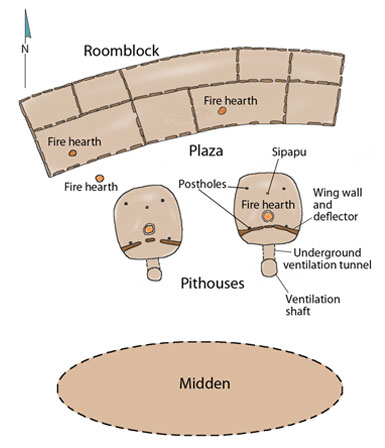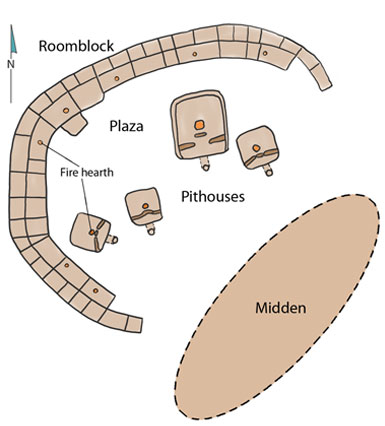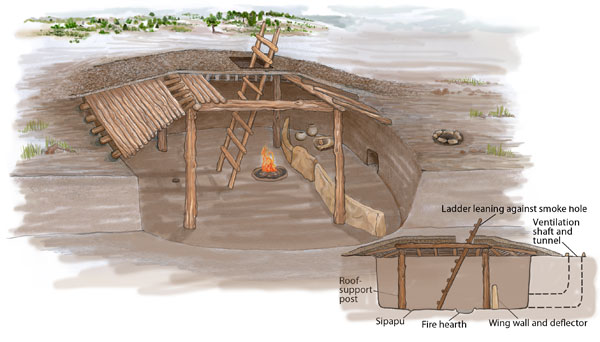Peoples of the Mesa Verde Region
The Pueblo I Period: A.D. 750 to 900Housing
Dramatic changes in housing took place during the Pueblo I period, changes in which archaeologists recognize the beginnings of true pueblo architecture. The word pueblo is Spanish for "town" or "village," and it was during the Pueblo I period that the first villages came into being in the Mesa Verde region. Any settlement with more than 50 rooms is considered by archaeologists to be a village. By the end of the Pueblo I period, most people were living in these larger settlements, although some families continued to live on small farmsteads. 
Map of Pueblo I farmstead (schematic). Early in the Pueblo I period, most people lived in small farmsteads like this one. Whether one lived on a farmstead or in a village, the biggest change in family housing during the Pueblo I period was the building of substantial aboveground rooms. One-story tall, these rooms were used not only for food storage but also for daily living. And, unlike the aboveground rooms of the Basketmaker III period, which were not connected to one another, those built during the Pueblo I period were constructed side-by-side, with "shared" walls. These groups of rooms are called "roomblocks," and they are usually located north of the pithouses. Some rooms were used exclusively for storing dried corn and other foodstuffs. Others have fire hearths and food-grinding tools in them, which indicates that people lived and worked in them for at least part of the year. The open area between the roomblock and the pithouses was a plaza, which was used as an additional work area when weather permitted. As during the preceding period, refuse accumulated in a designated midden area south of the pithouses. 
Map of Pueblo I village (schematic). By the end of the Pueblo I period, most people lived in these larger settlements. Early in the Pueblo I period, roomblocks were built with a combination of stone, plant materials, and adobe. Upright stone slabs formed the base of the walls, and wooden posts, brush, and adobe were used to construct the upper part of the walls, in the jacal fashion. Through time, more and more stone was incorporated into the construction of these rooms, so that by the end of the Pueblo I period, many rooms included walls that were at least partly masonry. Masonry walls consisted of stacked stone blocks, usually set in place with mortar. So what was happening with pithouses during this time? They were becoming deeper, and their roofs were becoming flatter. Some structures were up to 2 meters (6 to 7 feet) deep, and their roofs were nearly flush with the surrounding ground surface. Entry into these pithouses was exclusively through the smoke hole in the roof, because antechambers had been replaced by simple ventilation shafts, usually at the south end of the structure. Benches, common in Basketmaker III pithouses, became less common during the Pueblo I period, but other interior details, such as hearths, deflectors, and wing walls, were similar to those seen in earlier structures. Sometimes the deflector and wing walls were connected, forming a single low wall that spanned the structure. Hearths often had an adobe "collar" that rose slightly above the floor. 
"Cutaway" view of a Pueblo I pithouse, showing construction details and interior features. The smaller diagram shows a schematic cross section with the main features labeled. Archaeologists believe that people continued to live in pithouses at least during part of the year. But evidence also suggests that, in addition to the routine daily activities of cooking, eating, and sleeping, certain ritual functions may have been performed in Pueblo I pithouses. For example, the presence of a small, round pit called a sipapu (pronounced SEE-pah-poo) is often interpreted as evidence of ritual activity. When present, sipapus are located north of the hearth and are often filled with clean sand. Sipapus are thought by some Pueblo Indians to represent the hole from which humans emerged from the underworld. Great kivas, the large public buildings first seen during the Basketmaker III period, became larger and more common during the Pueblo I period. These underground structures, which were sizeable enough to accommodate many people, probably served the important social function of bringing members of the community together on important occasions. Finally, small, isolated structures consisting of one or two rooms were built next to agricultural fields during this time. Called "field houses," these structures allowed people to spend several days away from their villages in order to keep watch over their crops. |
|
Acknowledgments | Illustration credits | To borrow, cite, or request permission | Please take our survey! Title page for Peoples of the Mesa Verde Region |
|
 DONATE TODAY
DONATE TODAY
